
Dutch postcard, no. 435. Photo: Metro-Goldwyn-Mayer (M.G.M.). Sent by mail in 1934.

British postcard in the Picturegoer Series, London, 137a. Photo: Metro-Goldwyn-Mayer (M.G.M.).

British Real Photograph postcard, no. 28. A. Photo: Metro-Goldwyn-Mayer (M.G.M.).
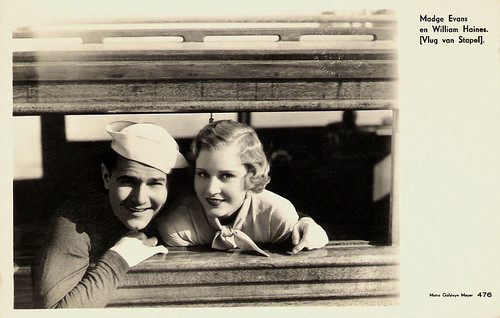
Dutch postcard, no. 476. Photo: Metro-Goldwyn-Mayer. William Haines and Madge Evans in Fast Life (Harry A. Pollard, Sam Wood, both uncredited, 1932), released in the Netherlands as Vlug van Stapel.
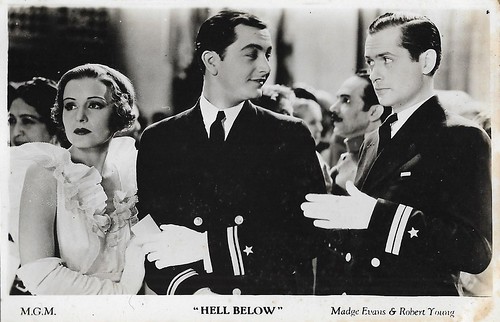
British postcard by Film Weekly. Photo: M.G.M. Madge Evans, Robert Young and Robert Montgomery in Hell Below (Jack Conway, 1933).
The Fairy Soap girl
Madge Evans was born Margherita Evans in 1909 in Manhattan. As an infant, she was featured in print ads as the 'Fairy Soap girl'. She made her professional debut at the age of six months, posing for artists. As a youth, her playmates included Robert Warwick, Holbrook Blinn, and Henry Hull. When she was four years old, Evans was featured in a series of child plays produced by William A. Brady. She worked at the old Long Island, New York movie studio.
Her success was immediate. Her mother loaned her daughter's name to a company for girl's hats. Evans posed in a mother and child tableau with Anita Stewart, then 16, for an Anheuser-Busch Brewing Company calendar, and as the little mountain girl in 'Heidi of the Alps'. At the age of eight in 1917, Evans appeared in the Broadway production of 'Peter Ibbetson' with John Barrymore, Constance Collier and Laura Hope Crews.
Evans' mother took her to England and Europe when she was 15. At 17, she returned to the stage and appeared as the ingenue in 'Daisy Mayme'. Some of her best work in plays came in productions of 'Dread', 'The Marquis', and 'The Conquering Male'. Her last appearance was in 'Philip Goes Forth' produced by George Kelley.
As a child film actress, Evans had quite a prolific career appearing in dozens of films, including The Sign of the Cross (Frederick A. Thomson, 1914) with Dustin Farnum, and The Seven Sisters (Sidney Olcott, 1915), with Marguerite Clark. The Seven Sisters (Sidney Olcott, 1915) had a large female ensemble that had been played on stage with Clark's rival Mary Pickford and Laurette Taylor in the cast.
Madge Evans was featured with Robert Warwick in Alias Jimmy Valentine (1915). At 14, she was the star of J. Stuart Blackton's rural melodrama On the Banks of the Wabash (1923). She co-starred with Richard Barthelmess in Classmates (1924).

American promotion postcard for Madge Evans Hat for Little Ladies, Sold exclusively by Pfeifers, Little Rock, Ark. Front side. Collection: Marlene Pilaete.

American promotion postcard for Madge Evans Hat for Little Ladies, Sold exclusively by Pfeifers, Little Rock, Ark. Back side. Collection: Marlene Pilaete.
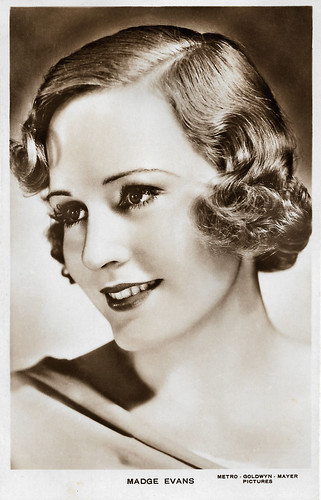
British postcard. Photo: Metro-Goldwyn-Mayer (M.G.M.).

Italian postcard by Cinema-Illustrazione, Milano, Series 1, no. 10. Photo: Metro-Goldwyn-Mayer. Cinema Illustrazione was an Italian popular film journal that existed between 1926 and 1939.

Dutch postcard by JosPe, Arnhem, no. 185. Photo: Metro-Goldwyn-Mayer.
Typical American girl roles
Madge Evans was working on stage when she signed with Metro Goldwyn Mayer in 1927. As in the theatre, she continued to play ingenue parts, often as the fiancé of the leading man. She played the love interest to both Al Jolson and Frank Morgan in the film Hallelujah, I'm a Bum (1933).
Working for MGM in the 1930s, she appeared as Lionel Barrymore's daughter in Dinner at Eight (George Cukor, 1933), and as the dependable Agnes Wickfield in David Copperfield (George Cukor, 1935). In 1933, she starred with James Cagney in a melodrama entitled The Mayor of Hell (Archie Mayo, Michael Curtiz (uncredited), 1933), playing a pretty nurse who solicits the aid of a tough politician, played by Cagney.
Other notable films in which she appeared are Beauty for Sale (Richard Boleslawski, 1933), Fugitive Lovers (Richard Boleslawski, 1934), and Pennies From Heaven (Norman Z. McLeod, 1936) with Bing Crosby. I.S.Mowis at IMDb: "Many of her 'typical American girl' roles did not allow her to express aspects of the greater acting range she undoubtedly possessed. Too often she was cast as the 'nice girl' - and those rarely make much of a dramatic impact."
On the few occasions, she was assigned the role of 'other woman', such as the Helen Hayes-starrer What Every Woman Knows (Gregory La Cava, 1934), audiences found her character difficult to believe and disassociate from her all-round wholesome image. When her contract with MGM expired in 1937, Madge wound down her film career and, following her 1939 marriage, concentrated on being the wife of celebrated playwright Sidney Kingsley. She last appeared on stage in one of his plays, 'The Patriots', in 1943.
In 1960, for Evans' contribution to the motion picture industry, she was honoured with a star on the Hollywood Walk of Fame located at 1752 Vine Street. She was married to playwright Sidney Kingsley, best known for his plays 'Dead End' and 'Detective Story' which were turned into popular films. The couple owned a 250-acre (1,000,000 m2) estate in Oakland, New Jersey. Later, she worked in radio and television in New York City. Evans performed on the Philco Television Playhouse (1949–1950), Studio One (1954), Matinee Theater (1955), and The Alcoa Hour (1956). Madge Evans died at her home in Oakland, New Jersey from cancer in 1981, aged 71.
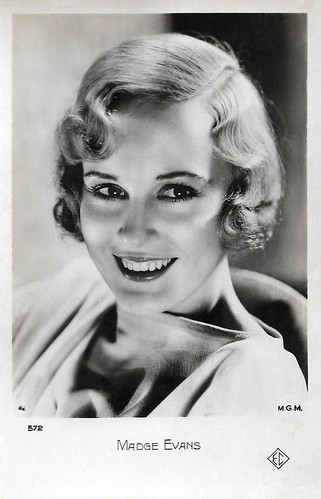
French postcard by Editions Chantal, Paris (EC), no. 572. Photo: M.G.M.

Dutch postcard by JosPe, Arnhem, no. 153. Photo: Metro-Goldwyn-Mayer (M.G.M.).

Dutch postcard, no. 159. Photo: Metro-Goldwyn-Mayer (M.G.M.). Sent by mail in 1932.
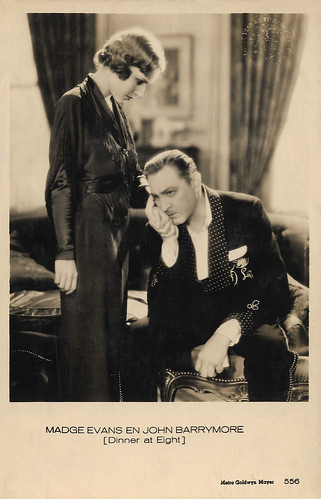
Dutch postcard, no. 556. Photo: M.G.M. Madge Evans and John Barrymore in Dinner at Eight (George Cukor, 1933).
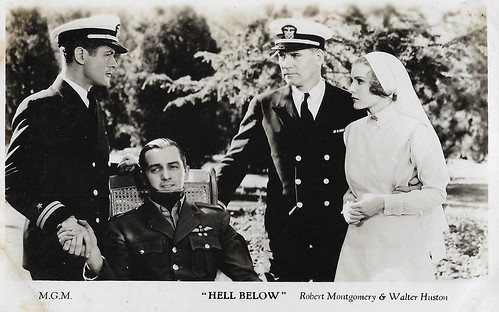
British postcard by Film Weekly. Photo: MGM. Robert Montgomery, Edwin Styles, Walter Huston, and Madge Evans in Hell Below (Jack Conway, 1933).

Dutch postcard, no. 486. Photo: Metro-Goldwyn-Mayer. Sent by mail in 1938.
Sources: I.S.Mowis (IMDb), Wikipedia and IMDb.
No comments:
Post a Comment